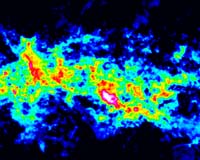 |
Cambridge MA (SPX) Jul 13, 2010 When a star explodes as a supernova, it shines so brightly that it can be seen from millions of light-years away. One particular supernova variety - Type Ia - brightens and dims so predictably that astronomers use them to measure the universe's expansion. The resulting discovery of dark energy and the accelerating universe rewrote our understanding of the cosmos. Yet the origin of these supernovae, which have proved so useful, remains unknown. "The question of what causes a Type Ia supernova is one of the great unsolved mysteries in astronomy," says Rosanne Di Stefano of the Harvard-Smithsonian Center for Astrophysics (CfA). Astronomers have very strong evidence that Type Ia supernovae come from exploding stellar remnants called white dwarfs. To detonate, the white dwarf must gain mass until it reaches a tipping point and can no longer support itself. There are two leading scenarios for the intermediate step from stable white dwarf to supernova, both of which require a companion star. In the first possibility, a white dwarf swallows gas blowing from a neighboring giant star. In the second possibility, two white dwarfs collide and merge. To establish which option is correct (or at least more common), astronomers look for evidence of these binary systems. Given the average rate of supernovae, scientists can estimate how many pre-supernova white dwarfs should exist in a galaxy. But the search for these progenitors has turned up mostly empty-handed. To hunt for accreting white dwarfs, astronomers looked for X-rays of a particular energy, produced when gas hitting the star's surface undergoes nuclear fusion. A typical galaxy should contain hundreds of such "super-soft" X-ray sources. Instead we see only a handful. As a result, a recent paper suggested that the alternative, merger scenario was the source of Type Ia supernovae, at least in many galaxies. That conclusion relies on the assumption that accreting white dwarfs will appear as super-soft X-ray sources when the incoming matter experiences nuclear fusion. Di Stefano and her colleagues have argued that the data do not support this hypothesis. In a new paper, Di Stefano takes the work a step further. She points out that a merger-induced supernova would also be preceded by an epoch during which a white dwarf accretes matter that should undergo nuclear fusion. White dwarfs are produced when stars age, and different stars age at different rates. Any close double white-dwarf system will pass through a phase in which the first-formed white dwarf gains and burns matter from its slower-aging companion. If these white dwarfs produce X-rays, then we should find roughly a hundred times as many super-soft X-ray sources as we do. Since both scenarios - an accretion-driven explosion and a merger-driven explosion - involve accretion and fusion at some point, the lack of super-soft X-ray sources would seem to rule out both types of progenitor. The alternative proposed by Di Stefano is that the white dwarfs are not luminous at X-ray wavelengths for long stretches of time. Perhaps material surrounding a white dwarf can absorb X-rays, or accreting white dwarfs might emit most of their energy at other wavelengths. If this is the correct explanation, says Di Stefano, "we must devise new methods to search for the elusive progenitors of Type Ia supernovae." Di Stefano's paper has been accepted for publication in The Astrophysical Journal and is available online.Headquartered in Cambridge, Mass., the Harvard-Smithsonian Center for Astrophysics (CfA) is a joint collaboration between the Smithsonian Astrophysical Observatory and the Harvard College Observatory. CfA scientists, organized into six research divisions, study the origin, evolution and ultimate fate of the universe.
Share This Article With Planet Earth
Related Links Harvard-Smithsonian Center for Astrophysics (CfA) Stellar Chemistry, The Universe And All Within It
 Rain Of Giant Gas Clouds Create Active Galactic Nuclei
Rain Of Giant Gas Clouds Create Active Galactic NucleiWashington DC (SPX) Jul 09, 2010 Galaxies like our own were built billions of years ago from a deluge of giant clouds of gas, some of which continue to rain down. Now new calculations tie the rain of giant clouds of gas to active galactic nuclei (AGN), the extremely bright centers of some galaxies. If a gas cloud with millions of times more mass than our Sun wanders too close to the center of a galaxy, it can either be co ... read more |
|
| The content herein, unless otherwise known to be public domain, are Copyright 1995-2010 - SpaceDaily. AFP and UPI Wire Stories are copyright Agence France-Presse and United Press International. ESA Portal Reports are copyright European Space Agency. All NASA sourced material is public domain. Additional copyrights may apply in whole or part to other bona fide parties. Advertising does not imply endorsement,agreement or approval of any opinions, statements or information provided by SpaceDaily on any Web page published or hosted by SpaceDaily. Privacy Statement |